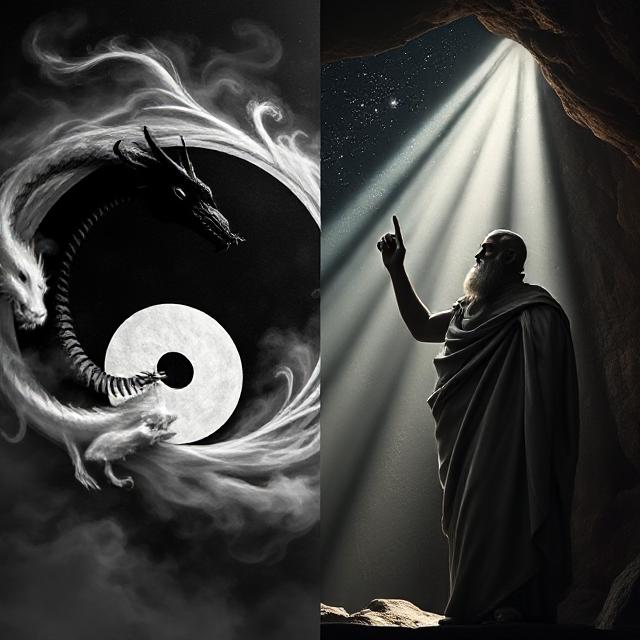
Table of Contents
Yin and Yang vs Platonic Dualism: Two Paths to Truth
Few concepts are as central to their respective philosophical traditions as yin and yang in Chinese thought and Platonic dualism in Western philosophy. Each offers a metaphysical model for understanding reality, identity, and morality, yet they arise from distinct cultural premises. To compare yin and yang vs Platonic dualism is to contrast two worldviews: one rooted in interdependence and harmony, the other in division and transcendence.
This article explores these frameworks in depth, tracing their historical origins, metaphysical assumptions, ethical implications, and relevance to the modern world.
I. Origins and Core Concepts
A. Yin and Yang: Harmony Through Complementarity
Yin and yang emerge from ancient Chinese cosmology and Daoist philosophy. They represent interdependent opposites found in all aspects of the universe:
- Yin: dark, passive, feminine, cool, receptive
- Yang: light, active, masculine, hot, assertive
Neither is superior; both are mutually defining and cyclically transforming. The Tao Te Ching emphasizes:
“When people see things as beautiful, ugliness is created. When people see things as good, evil is created.”
Reality is non-dualistic in essence, even if dualities appear. The focus is on balance, fluidity, and transformation.
B. Platonic Dualism: Reality in Two Realms
Plato, in works like the Republic and Phaedo, proposed that existence consists of two realms:
- The World of Forms: eternal, perfect, intelligible
- The Material World: changing, imperfect, perceptible
True knowledge (episteme) involves grasping the unchanging Forms through reason, not the senses. The soul, too, is distinct from the body, yearning to escape material bondage and return to the world of ideals.
“The body is the prison of the soul.” — Plato
II. Metaphysical Frameworks Compared
| Feature | Yin and Yang | Platonic Dualism |
|---|---|---|
| Nature of Reality | Dynamic unity of opposites | Static division between forms and matter |
| Dualism Type | Complementary, interdependent | Hierarchical, oppositional |
| Change and Becoming | Central, cyclical, and natural | Illusory or lesser than eternal truths |
| Goal of Philosophy | Harmonize with the Dao | Ascend to the World of Forms |
Yin-yang assumes the world is a living, breathing system of flows and counterflows. Platonic thought views the physical as mere shadow of true reality.
III. Implications for Ethics and the Self
A. The Self in Yin-Yang Thought
The self is relational, part of an ecosystem of forces. Balance, not dominance, is key. Moral cultivation involves:
- Moderation (the Doctrine of the Mean)
- Aligning with the Dao
- Honoring cycles and rhythms
There is no rigid separation between mind and body, self and world, or good and evil—only context-dependent harmony.
B. The Soul in Platonic Dualism
The Platonic soul is eternal and rational, trapped in a perishable body. Ethics becomes the art of:
- Restraining desires
- Pursuing truth through dialectic
- Escaping material illusion
Moral life is about purifying the soul, detaching from the corruptible body, and aligning with the eternal Good.
IV. Symbolism and Representation
A. The Yin-Yang Symbol
The familiar taijitu depicts black (yin) and white (yang) swirling together with dots of the opposite color within each:
- Suggests fluidity and mutual containment
- Symbolizes natural balance, not moral struggle
B. Plato’s Allegory of the Cave
In the Republic, Plato describes prisoners in a cave, mistaking shadows for reality. One escapes, sees the real world, and returns to free the others. This allegory underscores:
- The illusion of sense perception
- The difficulty of enlightenment
- The nobility of philosophical awakening
Where yin and yang embrace transformation within reality, Plato sees truth as lying beyond appearance.
V. Relevance in the Modern World
A. Applications of Yin-Yang Thought
- Medicine: Traditional Chinese medicine uses yin-yang to diagnose and balance health
- Psychology: Integrative therapies emphasize masculine-feminine, active-passive integration
- Ecology: Harmony with nature echoes yin-yang logic of mutual sustenance
B. Influence of Platonic Dualism
- Science: The separation of mind and matter underpins Cartesian methodology
- Religion: Heaven vs earth, soul vs sin—deeply rooted in Platonic separation
- Ethics: Focus on absolutes, universal principles, and rational control
In some cases, Platonic dualism has led to alienation from the body and the natural world. Yin-yang models, conversely, encourage reconnection and integration.
VI. Can These Frameworks Be Reconciled?
A. Beyond Either/Or
Modern thinkers like Alan Watts, Carl Jung, and Ken Wilber have explored ways to synthesize East and West:
- Acknowledge transcendence and immanence
- Balance rational inquiry with intuitive awareness
- Use dialectic and paradox together as tools of wisdom
B. The Value of Tension
Rather than dismiss one view, we might see them as complementary lenses:
- Yin and yang reveal how things relate
- Platonic dualism asks what things ultimately are
Both are incomplete alone. Together, they offer a richer, more flexible model of reality.
Conclusion: Two Visions, One Mystery
In comparing yin and yang vs Platonic dualism, we encounter two ancient yet enduring visions of truth. The East invites us to dance with paradox and balance, while the West urges us to transcend illusion and pursue purity.
Neither is the whole story—but each adds depth to our quest. When fused thoughtfully, they reveal not answers, but a deeper ability to question, reflect, and live wisely.
